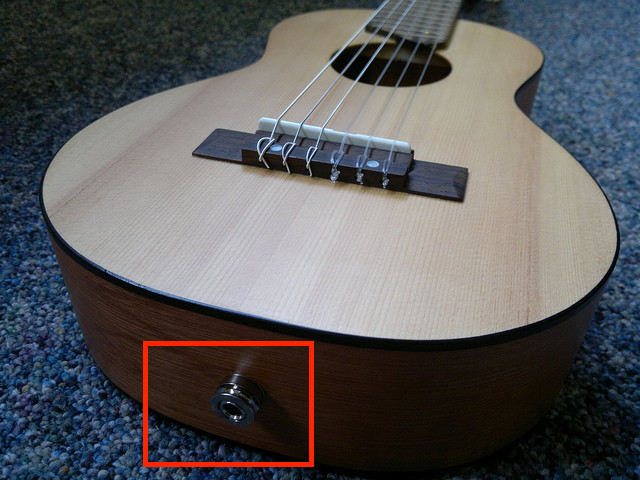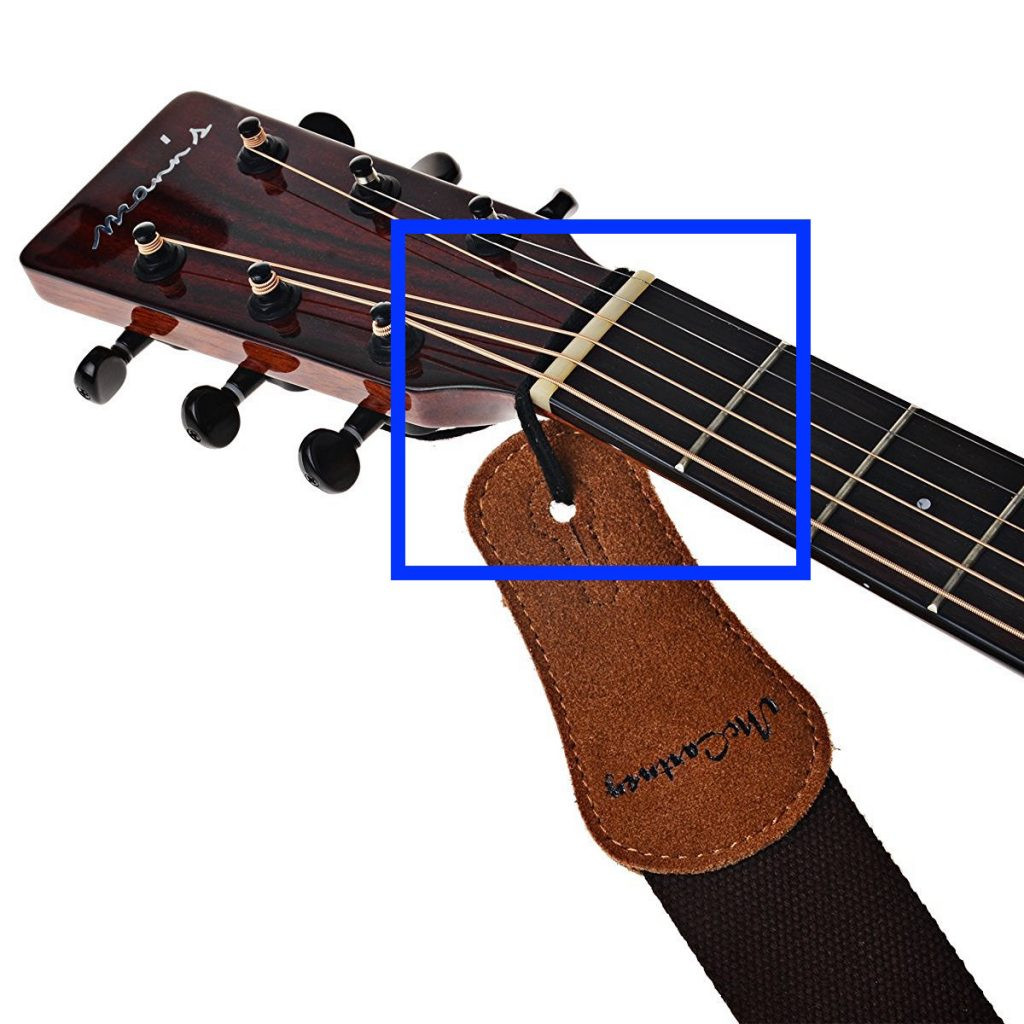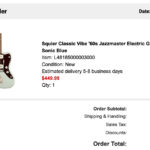If you’re diving into the world of acoustic guitar playing, understanding how to properly attach a guitar strap is a fundamental skill. While it might seem straightforward, ensuring your strap is securely fastened is crucial for comfortable practice sessions, confident stage performances, and, most importantly, the safety of your instrument. Whether you’re a complete beginner or just want to double-check your technique, this guide will walk you through the process of attaching a guitar strap to your acoustic guitar with ease.
Understanding Your Guitar Strap and Acoustic Guitar
Before we get hands-on, let’s briefly understand the components involved. A guitar strap is designed to support your guitar at a comfortable playing height when you’re standing. Acoustic guitars, unlike electric guitars, sometimes have different configurations for strap attachment points.
Identifying Strap Buttons on Your Acoustic Guitar
The most common way to attach a guitar strap is using strap buttons, also known as strap pegs. These are small, usually metal, knobs that protrude from the guitar body. Here’s where you’ll typically find them on an acoustic guitar:
-
Bottom of the Body: Almost all acoustic guitars will have a strap button located at the very bottom of the guitar body, often integrated into the endpin jack if your guitar has electronics.
 how-to-attach-a-guitar-strap
how-to-attach-a-guitar-strapAlt: Close-up of an acoustic guitar body showing a strap button, illustrating how to attach a guitar strap to an acoustic guitar.
-
Heel of the Neck or Upper Bout: The second strap button, if present, is usually located in one of two places:
- Heel: At the base of the guitar neck where it joins the body (the “heel”).
- Upper Bout: On the upper side of the guitar body, near the neck joint.
If your guitar has these two buttons, attaching a strap is incredibly simple. However, some acoustic guitars, especially older or budget models, might only have one button at the bottom. Don’t worry; we’ll cover how to attach a strap even if you’re missing that second button.
Method 1: Attaching a Strap to Acoustic Guitars with Two Strap Buttons
This is the most straightforward method and the most secure.
-
Locate the strap buttonholes on your guitar strap. Most guitar straps have buttonholes at each end, usually reinforced with leather or a similar material.
-
Attach one end of the strap to the bottom strap button. Widen the buttonhole slightly if needed (especially on new straps) and push it over the button. Ensure the strap is securely seated around the button, so it won’t slip off. It should fit snugly.
-
Attach the other end of the strap to the second strap button. Repeat the process, attaching the other end of the strap to the button located at the heel or upper bout of your guitar.
That’s it! Your strap is now attached. Before you start playing while standing, give the strap a gentle tug at each button to ensure it’s securely fastened.
Method 2: Attaching a Strap to Acoustic Guitars with One Strap Button (or None)
If your acoustic guitar only has one strap button at the bottom, or lacks a button on the neck side, you’ll need to use an alternative method for the neck-side attachment. The most common solution is using a string or a dedicated headstock strap adapter.
Using a String or Shoelace Method
This is a traditional and cost-effective way to attach a strap when you only have one button. You’ll need a sturdy string, shoelace, or even a piece of paracord.
-
Attach one end of your strap to the bottom strap button just as you would in Method 1.
-
Prepare your string or shoelace. It should be long enough to securely tie around the guitar’s headstock.
-
Thread the string through the buttonhole at the free end of your guitar strap.
-
Position the string above the guitar’s nut and under the strings. Carefully thread the string under the guitar strings, just above the nut (the white or black piece at the top of the fretboard). Make sure the string goes under the strings, not over them, to avoid affecting tuning or sound.
 string-to-attach-guitar-strap
string-to-attach-guitar-strapAlt: Detail view of a guitar strap tied to the headstock of an acoustic guitar with a string, demonstrating an alternative method for strap attachment.
-
Tie the string securely around the headstock. Bring the string around the guitar headstock, above the nut, and tie it off securely. A simple knot like a square knot or a bowline knot will work well. Ensure the knot is tight and the strap feels secure.
Alternative: Headstock Strap Adapters
For a more convenient and often more aesthetically pleasing solution than a string, you can use a headstock strap adapter. These are specifically designed straps or attachments that loop around the headstock and provide a secure point to attach your guitar strap. They come in various materials like leather or nylon and often feature a button or loop to connect your regular strap.
Alt: A snap-on guitar strap attachment securing a guitar strap to the headstock of an acoustic guitar, showcasing a convenient strap solution.
These adapters are easy to install and remove and offer a reliable way to attach a strap to guitars without a second strap button. Many guitarists prefer them for their clean look and ease of use.
Essential Tips for Using Your Guitar Strap
Once your strap is attached, here are some crucial tips to keep in mind:
Practice Standing Up
If you plan to perform or play with others while standing, it’s essential to practice standing up with your strap. Playing while standing is a different experience than sitting, and it’s important to get comfortable with the balance and posture. Practicing standing will help you adjust to the new playing position and prevent discomfort or strain during performances.
Test Your Strap Security Regularly
Before each playing session, especially when standing, always test the security of your strap. Give it a gentle but firm tug at each attachment point to ensure it’s properly secured and won’t slip off during playing. Regularly inspect your strap and buttonholes for wear and tear. Consider using strap locks for extra security, especially if you play valuable instruments or perform energetically. Strap locks replace your existing strap buttons and provide a locking mechanism that prevents the strap from accidentally detaching.
Adjust the Strap Length for Comfort and Playing Style
Experiment with different strap lengths to find what’s most comfortable for you. The ideal strap length depends on your height, playing style, and personal preference. A common starting point is to adjust the strap so your guitar hangs around your waist level or slightly higher. Some players prefer the guitar to hang lower for a certain look or playing style, while others prefer it higher for easier access to the fretboard. Acoustic guitarists often find a slightly higher guitar position comfortable for strumming and fingerpicking. Electric guitarists may prefer a lower position. Don’t be afraid to adjust and find what feels best for you.
Conclusion
Attaching a guitar strap to your acoustic guitar is a simple process that opens up a new dimension of playing and performing. By understanding the different methods and following these tips, you can confidently and comfortably play your acoustic guitar standing up. Whether you opt for the standard two-button method or utilize a string or headstock adapter, the key is to ensure your strap is securely attached and adjusted for your optimal playing experience. Now, strap on your guitar and enjoy playing with newfound freedom!

 snap-on-strap-guitar
snap-on-strap-guitar